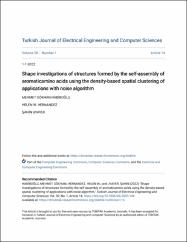| dc.contributor.author | Habiboğlu, Mehmet Gökhan | |
| dc.contributor.author | Hernandez, Helen W. | |
| dc.contributor.author | Uyaver, Şahin | |
| dc.date.accessioned | 2022-05-18T11:18:52Z | |
| dc.date.available | 2022-05-18T11:18:52Z | |
| dc.date.issued | 2022 | en_US |
| dc.identifier.citation | Habiboğlu, M. G., Hernandez, H. W., & Uyaver, Ş. (2022). Shape investigations of structures formed by the self-assembly of aromatic amino acids using the density-based spatial clustering of applications with noise algorithm. Turkish Journal of Electrical Engineering & Computer Sciences, 30(1), 200-215. | en_US |
| dc.identifier.issn | 1303-6203 | |
| dc.identifier.uri | https://hdl.handle.net/20.500.12846/650 | |
| dc.description.abstract | Tyrosine, tryptophan, and phenylalanine are important aromatic amino acids for human health. If they are not properly metabolized, severe rare mental or metabolic diseases can emerge, many of which are not researched enough due to economic priorities. In our previous simulations, all three of these amino acids are discovered to be self-organizing and to have complex aggregations at different temperatures. Two of these essential stable formations are observed during our simulations: tubular-like and spherical-like structures. In this study, we develop and implement a clustering analyzing algorithm using density-based spatial clustering of applications with noise (DBSCAN) to measure the shapes of the formed structures by the self-assembly processes of these amino acids. We present the results in quantitative and qualitative ways. To the best of our knowledge, the geometric shapes of the formed structures by the self-assembly processes of these amino acids are not measured quantitatively in the literature. Analytical measurements and comparisons of these aggregations might help us to identify the self-aggregations quickly at early stages in our simulations and hence provide us with more opportunity to experiment with different parameters of the molecular simulations (like temperature, mixture rates, and density). We first implement the DBSCAN method to identify the main self-aggregation cluster and then we develop and implement two algorithms to measure the shapes of the formed structures by the self-assembly processes of these amino acids. The measurements, which are completely in line with our simulation results, are presented in quantitative and qualitative ways. | en_US |
| dc.language.iso | eng | en_US |
| dc.publisher | Scientific & Technical Research Council Turkey-TUBITAK | en_US |
| dc.relation.isversionof | 10.3906/elk-2003-144 | en_US |
| dc.rights | info:eu-repo/semantics/openAccess | en_US |
| dc.subject | Clustering Analysis | en_US |
| dc.subject | Density-Based Spatial Clustering Of Applications With Noise | en_US |
| dc.subject | Self Assembly | en_US |
| dc.subject | Amino Acids | en_US |
| dc.subject | Sphericity | en_US |
| dc.subject | Cylindricity | en_US |
| dc.subject | Clusteranalyse | en_US |
| dc.subject | Selbstmontage | en_US |
| dc.subject | Aminosäuren | en_US |
| dc.subject | Sphärizität | en_US |
| dc.subject | Zylindrizität | en_US |
| dc.title | Shape investigations of structures formed by the self-assembly of aromatic amino acids using the density-based spatial clustering of applications with noise algorithm | en_US |
| dc.type | article | en_US |
| dc.relation.journal | Turkish Journal of Electrical Engineering And Computer Sciences | en_US |
| dc.contributor.authorID | 0000-0002-8334-7944 | en_US |
| dc.identifier.volume | 30 | en_US |
| dc.identifier.issue | 1 | en_US |
| dc.relation.publicationcategory | Makale - Uluslararası Hakemli Dergi - Kurum Öğretim Elemanı | en_US |
| dc.contributor.department | TAÜ, Mühendislik Fakültesi, Elektrik-Elektronik Mühendisliği Bölümü | en_US |
| dc.contributor.institutionauthor | Habiboğlu, Mehmet Gökhan | |
| dc.contributor.institutionauthor | Uyaver, Şahin | |
| dc.identifier.startpage | 200 | en_US |
| dc.identifier.endpage | 215 | en_US |
| dc.identifier.wosquality | Q4 | en_US |
| dc.identifier.scopusquality | Q3 | en_US |
| dc.identifier.wos | WOS:000746494300001 | en_US |

















